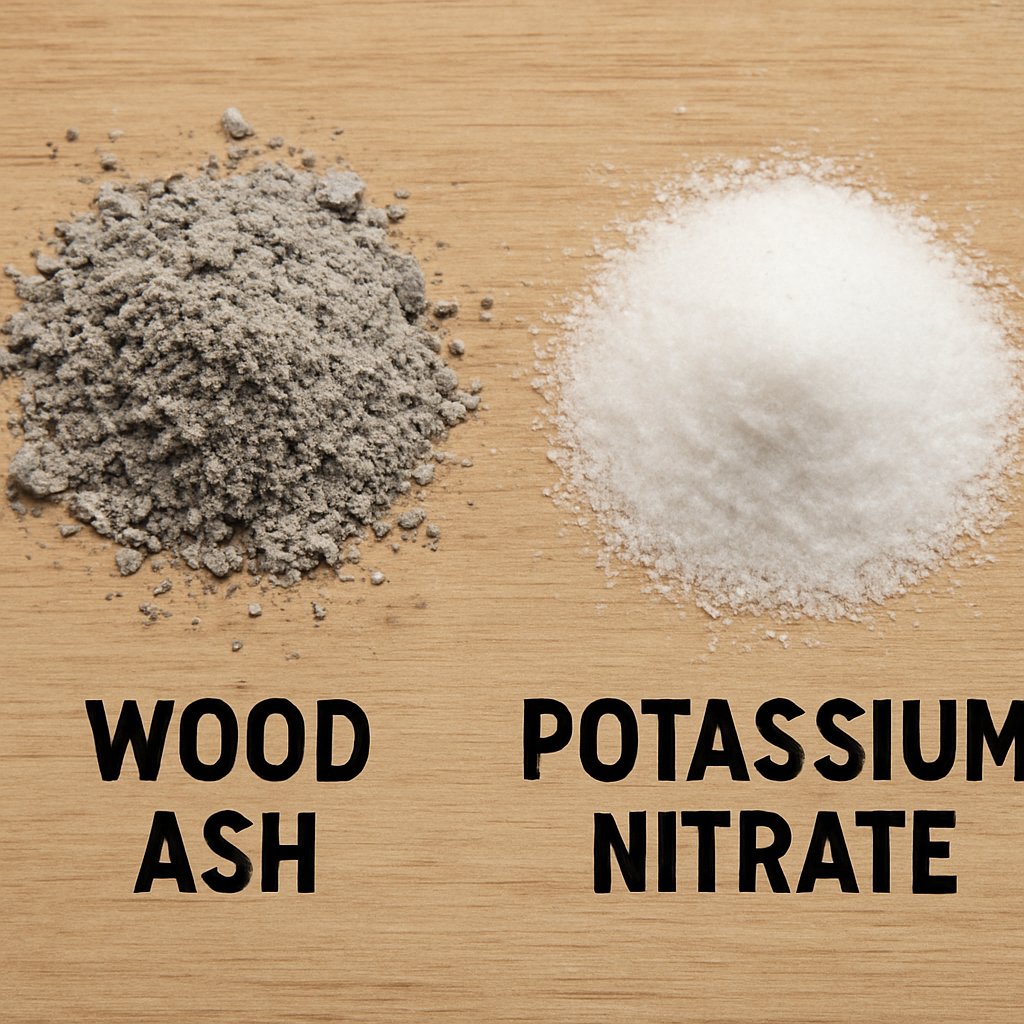Potassium nitrate, commonly known as saltpeter, is a versatile compound used in various applications ranging from fertilizers to fireworks. While you can purchase it from the store, did you know that you can also make potassium nitrate at home using wood ash? This guide will walk you through the process, step by step, using easily accessible materials.
Chemical Composition and Structure
Potassium nitrate is a naturally occurring mineral composed of potassium (K), nitrogen (N), and oxygen (O). Its chemical formula is KNO3. The combination of these elements gives it unique properties that make it valuable in various fields. The nitrogen content is particularly important for its role in agriculture, where it’s used to enhance plant growth by providing essential nutrients.
Historical Uses
Historically, potassium nitrate has been an important component in many industries. It was a critical ingredient in the production of gunpowder, a discovery that revolutionized warfare and mining. Its preservative properties also made it useful in food preservation before the advent of modern refrigeration, particularly in curing meats.
Modern Applications
In contemporary times, potassium nitrate’s roles have expanded. It’s used in the food industry as a curing agent and preservative. In agriculture, it’s prized for its ability to improve soil fertility and plant health. Additionally, its oxidizing properties make it a key ingredient in fireworks, providing the necessary reaction for colorful displays.
Why Make Potassium Nitrate from Wood Ash?
Sustainability and Environmental Benefits
Producing potassium nitrate from wood ash is a sustainable and cost-effective method. Wood ash, a byproduct of burning wood, is rich in potassium compounds. By extracting these compounds, you can create potassium nitrate without the need for expensive chemicals or equipment. Additionally, this process recycles waste, reducing environmental impact and conserving natural resources.
Cost-Effectiveness
Commercial potassium nitrate can be expensive, especially for large-scale agricultural use. By making it at home, you save money and gain control over the production process. This DIY approach allows for customization based on your specific needs, whether for gardening, crafting, or other applications.
Educational Value
The process of making potassium nitrate from wood ash is not only practical but also educational. It provides a hands-on learning experience in chemistry and resource management. This can be particularly beneficial for educational settings, where students can engage with real-world applications of chemical reactions and sustainability practices.
Materials Needed
To get started, gather the following materials:
- Hardwood ash (from sources like oak, maple, or other hardwoods)
- Water
- A large container (such as a plastic or stainless steel bucket)
- A smaller container for filtration
- Filter paper or a fine cloth
- A heat source
- A glass or stainless steel pot
- Protective gloves and eyewear
Step-by-Step Process
Step 1: Collect and Prepare Wood Ash
Begin by collecting wood ash from a source of hardwoods. Ensure the ash is free from contaminants like plastics or chemicals. Hardwood ash is preferable due to its higher potassium content compared to softwoods. It’s important to avoid ashes from treated wood, as they can contain harmful chemicals that may contaminate the potassium nitrate.
Step 2: Create a Lye Solution
Fill a large container with the wood ash and add water. Stir the mixture thoroughly to create a lye solution, which will help extract the potassium compounds. Allow the mixture to sit for several hours or overnight, stirring occasionally. This process leaches the potassium carbonate from the ash into the water. The longer the ash steeps, the more potassium carbonate is extracted, enhancing the effectiveness of the solution.
Step 3: Filter the Solution
After the lye solution has settled, carefully pour the liquid into a smaller container, using a filter paper or fine cloth to remove solid particles. This filtered solution is rich in potassium carbonate, which is the precursor to potassium nitrate. Ensure that the filtering process is thorough to avoid any ash residue, which can impede the crystallization process later on.
Step 4: Boil the Solution
Pour the filtered solution into a glass or stainless steel pot. Heat the solution over a stove or another heat source, bringing it to a boil. Boiling the solution helps to concentrate it by evaporating excess water. Continuously stirring the solution during this stage ensures even heating and prevents the solution from boiling over, which can lead to loss of valuable compounds.
Step 5: Crystallize the Potassium Nitrate
Continue boiling the solution until it reduces to about one-third of its original volume. At this point, turn off the heat and allow the solution to cool. As it cools, potassium nitrate crystals will begin to form. You may see these crystals appearing as a white, powdery substance. The cooling process is crucial, as it allows the potassium nitrate to separate from the solution naturally.
Step 6: Collect and Purify the Crystals
Once the solution has fully cooled, carefully collect the potassium nitrate crystals. You can further purify these crystals by dissolving them in a small amount of hot water and then allowing the solution to cool again, repeating the crystallization process. This additional purification step enhances the quality and purity of the potassium nitrate, making it suitable for more sensitive applications like food preservation or precise agricultural use.
Using Potassium Nitrate
Fertilizer Applications
Now that you have successfully made potassium nitrate, you can use it in various ways. As a fertilizer, potassium nitrate provides essential nutrients to plants, promoting healthy growth. Its balanced nutrient content helps in the development of strong roots and lush foliage, making it ideal for both ornamental plants and crops.
Fireworks and Pyrotechnics
In the realm of pyrotechnics, potassium nitrate is a key component in creating homemade fireworks. Its oxidizing properties are essential for the combustion reactions that produce colorful displays. While making fireworks at home can be exciting, it’s crucial to follow safety guidelines to prevent accidents.
Food Preservation
Potassium nitrate can also be used as a component in food preservation. Its ability to inhibit bacterial growth makes it effective in curing meats, helping to preserve flavor and extend shelf life. However, it’s important to use food-grade potassium nitrate and adhere to recommended usage levels to ensure safety.
Safety Precautions
While making potassium nitrate from wood ash is a relatively simple process, it is essential to observe safety precautions:
Personal Protective Equipment
- Wear protective gloves and eyewear when handling chemicals and hot solutions. This helps prevent skin irritation and eye injury, especially during the boiling and filtering stages.
Ventilation and Workspace Safety
- Ensure good ventilation in your workspace to avoid inhaling fumes. Working in a well-ventilated area minimizes the risk of respiratory issues, particularly during the creation of the lye solution and boiling processes.
Handling and Storage
- Handle all solutions and chemicals with care, as they can be corrosive. Proper storage of your finished potassium nitrate is also important; keep it in a dry, airtight container away from direct sunlight and moisture to maintain its effectiveness.
Conclusion
Making potassium nitrate from wood ash is a rewarding and educational process that demonstrates the resourcefulness of using natural materials. By following these steps, you can create a valuable compound for gardening, crafting, and more. Not only does this method save money, but it also reduces waste and encourages a sustainable approach to resource management. Whether you’re a gardening enthusiast or a DIY hobbyist, producing potassium nitrate at home is a practical skill worth mastering.
Now that you know how to make potassium nitrate from wood ash, you can embark on this exciting project and explore the various applications of this versatile compound. Enjoy your newfound ability to create potassium nitrate and the satisfaction of utilizing natural resources responsibly.




